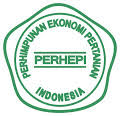Strategi Pengembangan Usahatani Kumbili Sebagai Komoditas Pangan Lokal Di Kabupaten Pandeglang
Strategi Pengembangan Usahatani Kumbili Sebagai Komoditas Pangan Lokal Di Kabupaten Pandeglang
DOI:
https://doi.org/10.25181/jofsa.v8i1.3071Keywords:
Local Food Commodities, Kumbili, Development Strategy, FarmingAbstract
The strategy for developing Kumbili farming as a Local Food Commodity in Pandeglang Regency consists of internal and external factors. The aim of the research is to analyze the strategy for developing kumbili farming as a local food commodity in Pandeglang district. The type of research is a survey, the respondents of the research are 30 kumbili farmers, the data analysis used is SWOT analysis. The IFE matrix shows that the biggest strength is the relatively high price compared to other commodities, each score is 0.67 with a weight of 0.17 rating 4. Internal factors of weakness are the lack of application of technology and business management and the absence of diversification of processed food products, each score is 0 .67 and a weight of 0.17 a rating of 4. The EFE matrix shows the highest opportunity is increased market demand with a weight of 0.25 rating 4, a score of 1.00, the biggest threat to inconsistent product quality, a weight of 0.25, a rating of 4 and a score of 1.00. The IE matrix shows IFE on the X axis of 3.52 and a total EFE weight score on the Y axis of 3.38, this shows the development of farming in Grow and Build conditions. Based on the SWOT analysis, strategies can be applied: the S-O (Strength-Opportunity) strategy optimizes natural conditions suitable for growing conditions, optimizes support from government agencies, maintains and improves product quality based on farmer experience. The W-O (Weakness-Opportunity) strategy allocates resources to adopt relevant technologies, increase farmer skills and knowledge, establish partnerships, focus on market segmentation including export potential, optimize business scale. The S-T (Strength-Threaths) strategy optimizes the use of supportive natural conditions based on farmer experience, takes advantage of market potential, maintains product quality and is consistent so that it is able to determine prices. The W-T (Weakness-Threaths) strategy simplifies operations, implements management, collaborates on product research and development, improves supply chain management systems, considers appropriate technology to improve product efficiency and consistency, expands market share. The development of kumbili farming provides benefits: increasing income, diversifying farming, opening up opportunities to improve the economy, creating jobs, facilitating the community to achieve food self-sufficiency reducing dependence on imported food and family expenses to buy household food.Downloads
References
Evelyn. (2018). Analisis Manajemen Strategi Bersaing dengan Matriks IE, Matriks SWOT dan Matriks QSPM Pada PT XYZ. Jurnal Manajemen Bisnis Dan Kewirausahaan, 2(4), 99–106.
Handayani, S., Noer, I., & Desfaryani, R. (2022). Development Strategy of Organic Rice in Lampung Selatan Regency. IOP Conference Series: Earth and Environmental Science, 1012(1). https://doi.org/10.1088/1755-1315/1012/1/012030
Hastuti, & Khotimah, N. (2017). Model Pengembangan Desa Wisata Berbasis Komoditas Lokal Di Kabupaten Bantul Daerah Istimewa Yogyakarta. Jurnal Penelitian Humaniora, 22(2), 92–98.
Istiqomah, & Andriyanto, I. (2018). Analisis SWOT dalam Pengembangan Bisnis. Jurnal Bisnis Dan Manajemen Islam, 5(2), 363–382.
Mirajiani, M., & Widiati, S. (2022). Pengetahuan Lokal Masyarakat Adat Baduy Dalam Pranata Sosial Untuk Menunjang Ketahanan Pangan. Jurnal Penyuluhan Dan Pemberdayaan Masyarakat (JPPM), 1(1), 1–8. https://doi.org/10.59066/jppm.v1i1.2
Mulyaningsih, A., & Astuti, A. (2022). Strategi Pemberdayaan Petani Dalam Mendukung Diversifikasi Pangan Lokal Di Kabupaten Pandeglang. Jurnal Agribisnis Terpadu, 15(1), 26–42. https://doi.org/10.33512/jat.v15i1.15438
Primalasari, I., & Puspitasari, M. S. (2021). Analisis Pendapatan Usahatani Padi Organik dan Kontribusinya Terhadap Pendapatan Rumahtangga Di Kecamatan BTS Ulu Kabupaten Musi Rawas. Journal of Food System and Agribusiness, 5(2), 99–106. https://doi.org/10.25181/jofsa.v5i2.1959
Septianingsih,I., (2023). Prospek Pengembangan Agribisnis Pangan Lokal Kumbili (Kentang Hitam) Solanum rotundifolius Sebagai Pangan Alternatif Pengganti Karbohidrat. Tesis Magister Ilmu Pertanian. Pascsarjana Universitas Sultan Ageng Tirtayasa, 1-142.
Subaktilah, Y., Kuswardani, N., & Yuwanti, S. (2018). ANALISIS SWOT: Faktor Internal Dan Eksternal Pada Pengembangan Usaha Gula Merah Tebu (Studi Kasus di UKM Bumi Asih, Kabupaten Bondowoso). Jurnal Agroteknologi, 12(02), 107–115. https://doi.org/10.19184/j-agt.v12i02.9276
Suharsimi, A. (2012). Prosedur Penelitian Suatu Pendekatan Praktik. Jakarta: PT Rineka cipta. (PT Rineka Cipta, ed.). Jakarta.
Widiati, S., & Azkia, L. I. (2023). Strategi Pengembangan Usaha Dan Peran Sertifikasi Halal Produk Pangan Lokal Umkm Dalam Menunjang Ketahanan Pangan Tingkat Rumah Tangga. Sebatik, 27(1), 398–406. https://doi.org/10.46984/sebatik.v27i1.2275
Widiati, S., Sutisna, T., Ikhsan, A., & Suherman. (2023). Analysis of Oil Palm Farmer Households Food Security and Nutrition Based on the Share of Food Expenditures and Energy Consumption. Journal of Nutrition Science, 4(1), 46–51. https://doi.org/10.35308/jns.v4v1.7647
Downloads
Published
How to Cite
Issue
Section
License
Copyright (c) 2024 Journal of Food System and Agribusiness

This work is licensed under a Creative Commons Attribution-NonCommercial 4.0 International License.
With the receipt of the article by the Journal of Food System and Agribusiness Editorial Board and the decision to be published, then the copyright regarding the article will be diverted to the Journal of Food System and Agribusiness.
Politeknik Negeri Lampung as the publisher of the Journal of Food System and Agribusiness holds the copyright regarding all the published articles in this journal.
Politeknik Negeri Lampung has the right to multiply and distribute the article and every author is not allowed to publish the same article that was published in this journal.
The manuscript authenticity and copyright statement submission can be downloaded ON THIS FORM. Fill out the form and submit as a supplementary file.
All publications by Journal of Food System and Agribusiness is licensed under a Creative Commons Attribution Non-Commercial 4.0 International License.
























